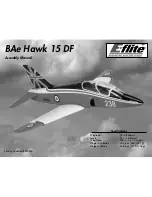
2
E-flite BAe Hawk ARF Assembly Manual
Using the Manual
This manual is divided into sections to help make
assembly easier to understand, and to provide breaks
between each major section. In addition, check boxes
have been placed next to each step to keep track
of its completion. Steps with a single circle (
) are
performed once, while steps with two circles (
)
indicate that the step will require repeating, such as for
a right or left wing panel, two servos, etc.
Remember to take your time and follow the directions.
Contents of Kit/Parts Layout
Replacement Parts
EFL8026
Fuselage with side hatch
EFL8027
Canopy Hatch
EFL8028
Wing Panel
with Hinged Aileron Left
EFL8029
Wing Panel
with Hinged Aileron Right
EFL8030
Horizontal Stabilizer
with Elevator L & R
EFL8031
Pushrods and Carbon
Wing Tubes
EFL8032
Plastic Accessories
EFL8033
Landing Gear and Wheels
with Hardware
EFL8034
Control Hardware
Introduction
Designed as a trainer and light combat aircraft for use
by the British Royal Air Force, the British Aerospace
(BAe) Hawk was mainly used to teach air combat,
air-to-air firing, air-to-ground firing, low-altitude
flying techniques and operation procedures. There are
currently over 900 Hawks in operation and nearly 2
million flying hours have been logged on the Hawk.
E-flite’s BAe Hawk 15 DF ARF is a sport scale version
of the British trainer. Constructed of fiberglass and
balsa, the fuselage is prefinished with scale details. The
Hawk boasts the rare and very visible Central Flying
School airshow trim scheme from 1987 in red, white
and blue.
This performance model was designed around E-flite’s
Delta V 15 (69mm) fan unit and matched 15 DF
brushless motor. Pilots can use a 3-cell battery pack
or utilize a 4-cell battery pack for increased vertical
performance. The built-in fan mounts make installing
the fan easy—just drop in the fan unit and tighten four
screws. The removable front hatch also allows easy
access to the radio equipment and battery. The entire
trim scheme is prepainted, pre-trimmed, the wings are
covered in UltraCote
®
and all the decals have already
been applied.
Important Information
Regarding Warranty Information
Please read our Warranty and Liability Limitations
section on Page 32 before building this product. If you
as the Purchaser or user are not prepared to accept the
liability associated with the use of this Product, you are
advised to return this Product immediately in new and
unused condition to the place of purchase.
Table of Contents
Introduction ........................................................... 2
Important Information Regarding
Warranty Information ........................................ 2
Using the Manual ................................................... 2
Contents of Kit/Parts Layout .................................... 2
Recommended Radio Equipment ............................. 3
Required Tools and Adhesives ................................. 3
Optional Accessories .............................................. 3
Required Brushless Ducted Fan Setup ....................... 3
Note on Lithium Polymer Batteries ........................... 3
Warning ................................................................ 3
Fan Installation....................................................... 4
Aileron Servo Installation ........................................ 6
Aileron Linkage Installation ..................................... 8
Mounting the Main Wing Panels ........................... 11
Stabilizer Installation ............................................ 13
Elevator Installation .............................................. 17
Elevator Linkage Installation .................................. 19
Landing Gear Installation ...................................... 21
Nose Gear and Elevator Servo Installation ............. 23
Speed Control and Receiver Installation ................. 25
Canopy Installation .............................................. 26
Thrust Tube Installation .......................................... 28
Motor Battery Installation ...................................... 29
Accessory Installation ........................................... 29
Control Throws..................................................... 30
Center of Gravity ................................................. 31
Preflight ............................................................... 31
Range Test Your Radio .......................................... 32
Flying Your BAe Hawk .......................................... 32
Safety, Precautions and Warnings ......................... 32
Warranty Information ........................................... 32
Instructions for Disposal of WEEE by
Users in the European Union ............................ 34
2008 Official Academy of
Model Aeronautics Safety Code ....................... 35



































